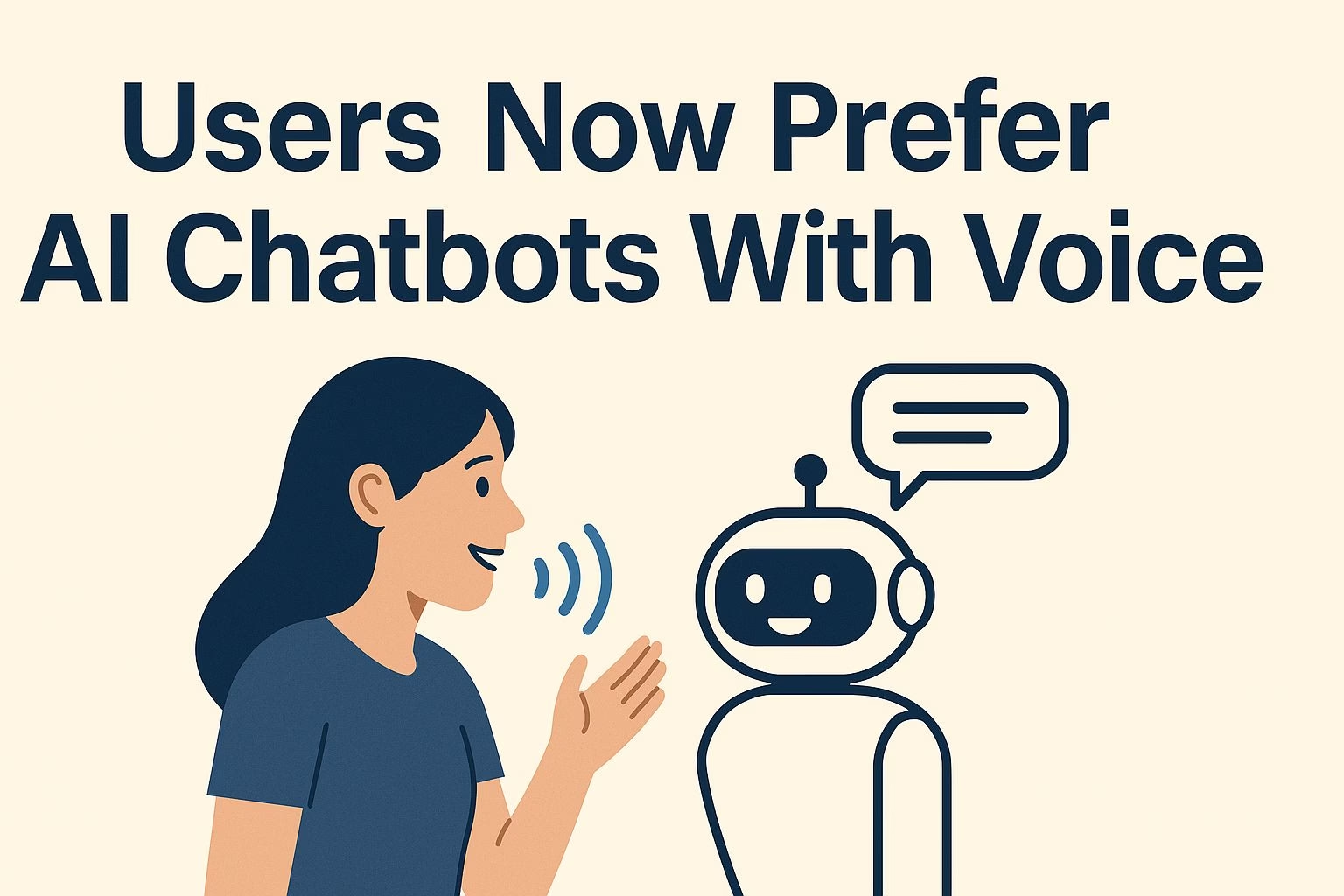Users Now Prefer AI Chatbots With Voice
AI users are tired of one-sided conversations. You type. It replies. You correct. It forgets. Every chat feels like starting from scratch.
That disconnect is more obvious now that voice chat is taking over.
Voice adds context. It brings tone, rhythm, and pacing. You don’t need to over-explain or repeat yourself. You speak, it responds.
The flow feels natural. And once people try it, going back to pure text feels like a downgrade.
That’s why users are moving toward AI chatbots with real-time voice. Not synthetic narration. Not text-to-speech summaries. Real back-and-forth voice. Think late-night talks, silly impressions, emotional check-ins. It’s all there, and users are noticing.
Text-only bots still dominate the mainstream, but they’re starting to look like landlines in the age of smartphones. You’ll see this shift playing out in forums, app reviews, and tool updates.
People want more. And the tools delivering voice are gaining fast.
Here’s what this article covers:
-
Why text-only bots fall short
-
What voice chat adds to the experience
-
Where major platforms lag behind
-
Which tools are leading this shift
-
What this means for AI moving forward
Text-Only Chatbots Feel Cold and Repetitive
Typing creates distance. You say something. It replies with a block of text. You scan it, then respond with another block.
The rhythm breaks. Emotional tone gets lost. Sarcasm gets misread. You explain things twice because the bot forgot the first part.
That’s been the experience for years. It works for basic tasks. But for longer chats, especially ones meant to feel personal, the magic fades fast.
Users who want emotional presence, casual banter, or immersive roleplay hit a wall.
Worse, many bots still reset or ignore context. You correct their tone or ask them to stay in character. Three replies later, they’re back to being robotic. It’s a loop that burns users out.
They want continuity. They want something that sounds alive.
Text alone rarely delivers that. Once people try voice-based chat, the difference is hard to ignore.
Voice Chat Adds Presence and Realism
Voice makes bots feel present. You speak, and they respond like a person in the room. You hear laughter, hesitation, warmth, or tension.
These cues don’t exist in plain text. Even the best-written responses miss the emotional nuance that voice brings.
You don’t need to write full sentences or think about punctuation. You just talk. That’s how real conversations work.
Voice bridges the gap between structured prompts and natural interaction. It makes casual chats feel effortless.
Voice also changes how people use chatbots. Instead of typing during a break or scrolling while distracted, users put on headphones and get lost in the moment.
They talk during walks. They vent in the dark. They roleplay full scenarios without pausing to type.
This shift isn’t about novelty. It’s about comfort. Voice feels easier, faster, and more real. That’s why tools that offer it are gaining attention—while the ones that don’t are falling behind.
Big Platforms Are Still Catching Up
OpenAI, Character AI, and others know users want voice. Some have introduced limited features. But access is gated, slow to roll out, or tied to specific models.
You need a Plus plan here, a voice pack there, and most features are still experimental.
Character AI rolled out voice for a few characters, but with restrictions. There’s lag, no real back-and-forth, and the voices sound canned.
Users who expected fluid conversations got short clips stitched together. That isn’t what they’re looking for.
OpenAI’s voice chat with GPT-4o is smoother, but only available to paid users. Even then, the voice personalities aren’t designed for long emotional sessions.
It’s still more assistant than companion. The voice is there, but the depth is missing.
Users want AI that talks like a person, not an interface. The demand is real, but the big names are still slow to adapt.
Smaller Tools Are Winning With Voice
Some lesser-known platforms are already doing voice better. Candy AI, for example, offers natural voice conversations with character consistency.
You speak, it replies, and the tone stays locked in. There’s no loading screen, no reset mid-chat.
Users on platforms like this spend longer in each session. They report higher satisfaction, stronger emotional engagement, and fewer complaints about memory loss or role-play breaks.
It’s not perfect, but it feels more human.
Others are building on that model. Voice is no longer an extra feature. It’s the core experience. These tools don’t try to imitate call centers or assistants. They focus on realism, comfort, and immersion.
That’s why they’re growing fast. While big platforms tweak filters and slowly roll out updates, smaller teams are locking in loyal users by giving them what they asked for from the start.
Voice Makes Sessions Longer and More Personal
Text chat has limits. Most users stay for a few minutes, drop a few messages, then leave. Voice changes that. Sessions stretch out. Conversations feel more like calls than chat logs.
Some users stay connected for hours.
This shift matters. Longer sessions mean stronger bonds between users and bots. People talk about their day, share personal stories, or roleplay full scenes without feeling rushed.
They come back more often because the experience feels real, not transactional.
Voice also makes bots more adaptable. You raise your voice, they notice. You pause, they fill the silence. That’s not possible with static text. These small things make a big difference in how users relate to the AI.
For people looking for comfort, connection, or entertainment, voice isn’t a luxury. It’s the reason they keep coming back.
This Shift Will Shape the Next Wave of AI Tools
As more users adopt voice chat, expectations are shifting. Tools that skip voice risk feeling outdated. New users aren’t asking if a bot types well.
They’re asking if it talks, listens, and stays consistent. Those are now baseline features.
Builders who want to stay relevant need to make voice a priority. Not voice notes. Not read-aloud text. Real voice chat with speed, memory, and emotional awareness.
The shift is already visible in product roadmaps. Voice is no longer on the sidelines. Teams are putting it front and center. The ones that wait too long will lose users to smaller platforms that already got it right.
If you’re building or choosing an AI companion today, voice should be part of the checklist.
Where We Go From Here
The rise of voice chatbots signals a clear shift. Users aren’t satisfied with walls of text and shallow replies. They want AI that listens, responds in real time, and feels close to human.
Voice makes that possible. Not in theory, but in use. Every day.
The platforms leading this shift are the ones paying attention to what users actually do—not what product managers predict. Voice drives retention. It increases session time.
It builds emotional weight into conversations that text alone cannot carry.
This isn’t a trend. It’s a direction. Text-only bots will still exist, but they won’t be enough. Users are moving toward tools that speak, and soon, they’ll expect nothing less.
Comparison Table: Voice Support in AI Chatbots
| Tool | Real-Time Voice Chat | Consistent Character Memory | Publicly Available | Notes |
|---|---|---|---|---|
| Candy AI | Yes | Yes | Yes | Natural voice, immersive RP |
| GPT-4o (OpenAI) | Yes (limited access) | No | Plus users only | More assistant-like tone |
| Character AI | Partial | No | Yes | Voice clips, not live chat |
| GPTgf | Yes | Yes | Yes | Casual tone, responsive voice |
| Janitor AI | No | Yes | Yes | Text-only, no voice support |
Note: Availability and features may change as platforms update their tools.

